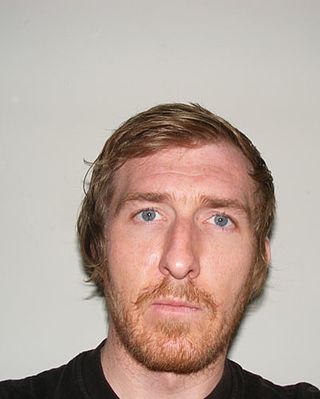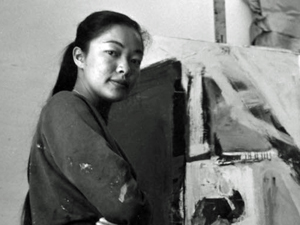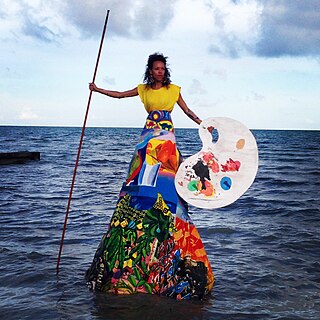Midori (美登里) is a sexologist, educator, author, artist, speaker, and coach. Midori wrote the first English language book with instruction on Japanese rope bondage and continues to write on alternative sexual practices, including BDSM and sexual fetishism, bondage, erotic fiction, and more. She teaches classes, presents at conferences, coaches individuals and professionals, and facilitates in-depth weekend intensives. She is based in San Francisco, California.

Peter Max Lawrence is a multidisciplinary contemporary artist, as well as performance artist, curator, filmmaker, and film director. He is known to work in painting, video installation, sculpture, photography and drawing. Lawrence has had art exhibitions in galleries throughout the United States and Europe. He has lived in San Francisco and Kansas City, Missouri.

Hulleah J. Tsinhnahjinnie is a Seminole-Muscogee-Navajo photographer, museum director, curator, and professor. She is living in Davis, California. She serves as the director of the C.N. Gorman Museum and teaches at University of California, Davis.

Bernice Bing was a Chinese American lesbian artist involved in the San Francisco Bay Area art scene in the 1960s. She was known for her interest in the Beats and Zen Buddhism, and for the "calligraphy-inspired abstraction" in her paintings, which she adopted after studying with Saburo Hasegawa.
Kim Anno is a Japanese-American artist known for her work as an abstract painter.
Jenifer K Wofford is an American contemporary artist and art educator based in San Francisco, California, United States. Known for her contributions to Filipino-American visual art, Wofford's work often addresses hybridity, authenticity and global culture, frequently from an ironic, humorous perspective. Wofford collaborates with artists Reanne Estrada and Eliza Barrios as the artist group Mail Order Brides/M.O.B. She is also the curator of Galleon Trade, an international art exchange among California, Mexico and the Philippines.

Michelle LaVallee is a Canadian curator, artist, and educator. She is Ojibway and a member of the Chippewas of Nawash Unceded First Nation in Cape Croker, Ontario. She has BFA (2000) and BEd (2004) degrees from York University in Toronto.
Dyani White Hawk is a contemporary artist and curator of Sicangu Lakota, German, and Welsh ancestry based out of Minnesota. From 2010 to 2015, White Hawk was a curator for the Minneapolis gallery All My Relations. As an artist, White Hawk's work aesthetic is characterized by a combination of modern abstract painting and traditional Lakota art. White Hawk's pieces reflect both her Western, American upbringing and her indigenous ancestors mediums and modes for creating visual art.

Paula Wilson is an African American "mixed media" artist creating works examining women's identities through a lens of cultural history. She uses sculpture, collage, painting, installation, and printmaking methods such as silkscreen, lithography, and woodblock. In 2007 Wilson moved from Brooklyn, New York, to Carrizozo, New Mexico, where she currently lives and works with her woodworking partner Mike Lagg.
Black Salt Collective is an American queer, women-of-color artist collective that currently consists of four California-based artists and curators: Sarah Biscarra-Dilley, Grace Rosario Perkins, Anna Luisa Petrisko, and Adee Roberson. Founded in 2012, Black Salt Collective's art practice crosses disciplines and media, including performance, video, installation, sound, painting, collage, textiles, sculpture, and printmaking.
Tarah Hogue is a Canadian curator and writer known for her work with Indigenous art. Hogue is of Métis and settler ancestry and resides in Saskatoon, Saskatchewan. She is the inaugural Curator at Remai Modern.
Cindy Shih is a Taiwanese-born American visual artist. Her work is strongly rooted in traditional techniques and principles, including Chinese literati painting, Venetian plasterwork, landscape painting, and realism, although producing thoroughly modern pieces. One of her prominent themes is exploring her personal narrative in a broad context. She lives in San Francisco, California.

Rosario Cooper (1845–1917) was a yak titʸu titʸu yak tiłhini woman who was the last known speaker of tiłhini, though she had rarely spoken or heard it since her early childhood. During the last years of her life, Rosario worked with the linguist J.P. Harrington to recover what she could recall of her native language, and the pair were able to document some grammatical structure, place names, songs, and cultural knowledge before she died in 1917. Cooper is considered to be the last known speaker of Obispeño, though there has been some recent revitalization.
Natalie Ball is a Klamath/Modoc interdisciplinary artist based in Chiloquin, Oregon.
Melissa Melero-Moose is a Northern Paiute/Modoc mixed-media artist and co-founder of Great Basin Native Artists, a collective based in Nevada. She is enrolled in the Paiute-Shoshone Tribe of the Fallon Reservation and Colony.
Tʼuyʼtʼtanat-Cease Wyss is a Skwxwú7mesh (Squamish), Stó꞉lō, Kānaka Maoli (Hawaiian), Irish-Métis, and Swiss multi-media artist, ethnobotanist, independent curator, educator, activist, and small business owner based in Vancouver, British Columbia. Tʼuyʼtʼtanat is Wyss's ancestral name, which means “woman who travels by canoe to gather medicines for all people.” Wyss's interdisciplinary practice encompasses aspects of visual art, fiber arts, ethnobotany, storytelling, and community education, among other interdisciplinary approaches, and she has been working with new media, performance, and interdisciplinary arts for more than 30 years. As a Coast Salish weaver, Wyss works with wool and cedar and uses indigenous plants in the dyeing process. Wyss also engages with beekeeping and gardening practices as part of community-led initiatives and as a way to explore aspects of land remediation - the ability of plants to remediate soil that has been contaminated with colonial toxins.
Patricia Marroquin Norby is the associate curator of Native American art at the Metropolitan Museum of Art. On September 14, 2020, she became the first full-time person of Indigenous descent hired for a curatorial position in the museum's 150-year history. Her Purépecha and Apache heritage has influenced her art since she was a young girl. She has worked for several museums and curated art of indigenous people, thoughtfully considering the lives of the artists and to faithfully present their art, breaking down past practices used by European Americans.

Alana Marissa Lopesi is a writer and critic based in Auckland, New Zealand. She has been published in multiple places in New Zealand and Australia, and has been an editor in chief at The Pantograph Punch. Her recent book Bloody Women is a series of essays which describes her experiences as a Samoan woman living in New Zealand.
Angela Hennessy is an American artist and educator. She is an Associate Professor at the California College of the Arts, and co-founder of SeeBlackWomxn. Hennessy teaches courses on visual and cultural narratives of death in contemporary art. She primarily works with textiles. She uses synthetic and human hair to create large-scale sculptures addressing cultural narratives of the body and mortality. Through writing, studio work, and performance, her practice addresses death and the dead themselves. Hennessy constructs “ephemeral and celestial forms” with every day gestures of domestic labor—washing, wrapping, stitching, weaving, brushing, and braiding.
Grace Rosario Perkins is a multidisciplinary artist whose works explore her the intersections of her Native American, queer and gender identities. She currently lives and works in Albuquerque, New Mexico. Although she is primarily a painter, Perkins also creates in other mediums, including video installations and masks. Perkins has been nominated for a San Francisco Museum of Modern Art (SFMoMA) Society for the Encouragement of Contemporary Art Award, a United States Arts Fellowship, a Tosa Studio Award, and a Liquitex Painter’s Residency. As well as her solo work, Perkins is a member of the Black Salt Collective.






